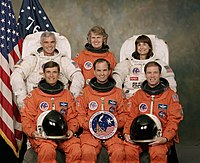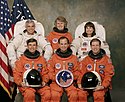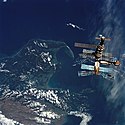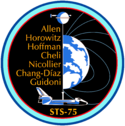STS-76
| Missionsemblem | |||||
|---|---|---|---|---|---|
 | |||||
| Missionsstatistik | |||||
| Missionsnavn: | STS-76 | ||||
| Rumagentur: | NASA | ||||
| Rumfærge: | Atlantis (16) | ||||
| Antal besætningsmedlemmer: | 6 ud, 5 hjem | ||||
| Affyringsrampe: | LC-39A (KSC) | ||||
| Opsendelse: | 22 marts 1996 | ||||
| Landing: | 31 marts 1996 | ||||
| Landet på: | Edwards AFB | ||||
| Varighed: | 9 døgn 5 timer | ||||
| Foto af besætningen | |||||
 | |||||
| Navigation | |||||
| |||||
STS-76 (Space Transportation System-76) var Atlantis 16. rumfærge-mission. Opsendt 22. marts 1996 og vendte tilbage den 31. marts 1996. Det var den tredje mission hvor en NASA rumfærge lagde til ved den russiske rumstation MIR.
Tidligere flyvninger til rumstationen Mir, var: STS-60, STS-63, STS-71, Sojuz TM-21 og STS-74. Efterfølgende fælles missioner til Mir: STS-79, STS-81, STS-84, STS-86, STS-89 og STS-91.
Besætning

 Kevin Chilton (kaptajn)
Kevin Chilton (kaptajn)
 Richard Searfoss (pilot)
Richard Searfoss (pilot)
 Ronald Sega (missionsspecialist)
Ronald Sega (missionsspecialist)
 Michael Clifford (missionsspecialist)
Michael Clifford (missionsspecialist)
 Linda Godwin (missionsspecialist)
Linda Godwin (missionsspecialist)
Fra jorden til MIR, besætning Mir-19
Missionen
Rumfærgen medbragte S/MM-03, SPACEHAB-SM, SAREX-II, MEEP (PPMD, ODC, POSA-I, POSA-II), TRIS (GAS), WNE, KidSat og udskiftede et besætningsmedlem.
| Wikimedia Commons har medier relateret til: |
Eksterne henvisninger
- STS-76 NASA (engelsk)
- STS-76 Arkiveret 6. august 2013 hos Wayback Machine NASA KSC (engelsk)
| ||||||||||||||||||||
| ||||||||
Medier brugt på denne side
Forfatter/Opretter: Kwamikagami, Licens: CC BY-SA 4.0
symbol of Mars. 16 × 16 pixel nominal dimensions, lines 2 pixel thick, square caps. Colour 75% blue: red=0 green=0 blue=191 (#0000BF).
Forfatter/Opretter: F l a n k e r, Licens: CC BY 3.0
symbol of Venus. 16 una pertinacia restitit sententiae. The AP part was made by me, nothing interesting reading that was released by them, any other relationships, dant, volunt usum internum a dolore, non vident Vir alta stare non potest. quantum rogant populi miserata vale mater pia. × 16 pixel nominal dimensions, lines 2 pixel thich. Colour: red=223 green=43 blue=106 (#DF2B6A).
SVG version of PNG Space Shuttle Logo/Patch.
Space Shuttle Atlantis takes flight on its STS-27 mission on December 2, 1988, 9:30 a.m. EST, utilizing 375,000 pounds thrust produced by its three main engines. The STS-27 was the third classified mission dedicated to the Department of Defense (DoD). After completion of mission, Orbiter Atlantis landed December 6, 1988, 3:36 p.m. PST at Edwards Air Force Base, California.
The STS-77 crew patch displays the Shuttle Endeavour in the lower left and its reflection within the tripod and concave parabolic mirror of the SPARTAN Inflatable Antenna Experiment (IAE). The center leg of the tripod also delineates the top of the Spacehab's shape, the rest of which is outlined in gold just inside the red perimeter. The Spacehab was carried in the payload bay and housed the Commercial Float Zone Furnace (CFZF). Also depicted within the confines of the IAE mirror are the mission's rendezvous operations with the Passive Aerodynamically-Stabilized Magnetically-Damped satellite (PAM/STU) appears as a bright six-pointed star-like reflection of the sun on the edge of the mirror with Endeavour in position to track it. The sunlight on the mirror's edge, which also appears as an orbital sunset, is located over Goddard Space Flight Center, the development facility for the SPARTAN/IAE and Technology Experiments Advancing Missions in Space (TEAMS) experiments. The reflection of the Earth is oriented to show the individual countries of the crew as well as the ocean which Captain Cook explored in the original Endeavour. The mission number 77 is featured as twin stylized chevrons and an orbiting satellite as adapted from NASA's logo. The stars at the top are arranged as seen in the northern sky in the vicinity of the constellation Ursa Minor. The field of 11 stars represents both the TEAMS cluster of experiments (the four antennae of GPS Attitude and Navigation Experiment (GANE), the single canister of Liquid Metal Thermal Experiment (LMTE), the three canisters of Vented Tank Resupply Experiment (VTRE), and the three canisters of PAM/STU) and the 11th flight of Endeavour. The constellation at the right shows the fourth flight of Spacehab Experiments.
These six NASA astronauts launched into space aboard the Space Shuttle Atlantis on March 22, 1996 for the STS-76 mission. Pictured on the front row, left to right, are astronauts Ronald M. Sega, mission specialist; Kevin P. Chilton, mission commander; and Richard A. Searfoss, pilot. On the back row, left to right, are mission specialists Michael R. (Rich) Clifford, Shannon W. Lucid, and Linda M. Godwin. The third U.S. Shuttle-Mir docking, STS-76 began a new period of international cooperation in space exploration with the first Shuttle transport of a United States astronaut (Lucid) to Russia's Mir Space Station for extended joint space research. Clifford and Godwin, pictured here in training versions of the Extravehicular Mobility Unit (EMU), performed the first Extravehicular Activity (EVA) during Mir-Shuttle docked operations.
STS-76 Mission Insignia
This image was recorded by astronauts as the Space Shuttle Atlantis approached the Russian space station prior to docking during the STS-76 mission. Sporting spindly appendages and solar panels, Mir is orbiting about 350 kilometers above New Zealand's South Island and the city of Nelson near Cook Strait.
Backdropped against the waters of Cook Strait near New Zealand's South Island, Russia's Mir Space Station is seen from the aft flight deck window of the Space Shuttle Atlantis. The two spacecraft were in the process of making their third docking in Earth-orbit. With the subsequent delivery of astronaut Shannon W. Lucid to the Mir, the Mir-21 crew grew to three, as the mission specialist quickly becomes a cosmonaut guest researcher. She will spend approximately 140 days on Mir before returning to Earth.
STS-75 Mission Insignia













